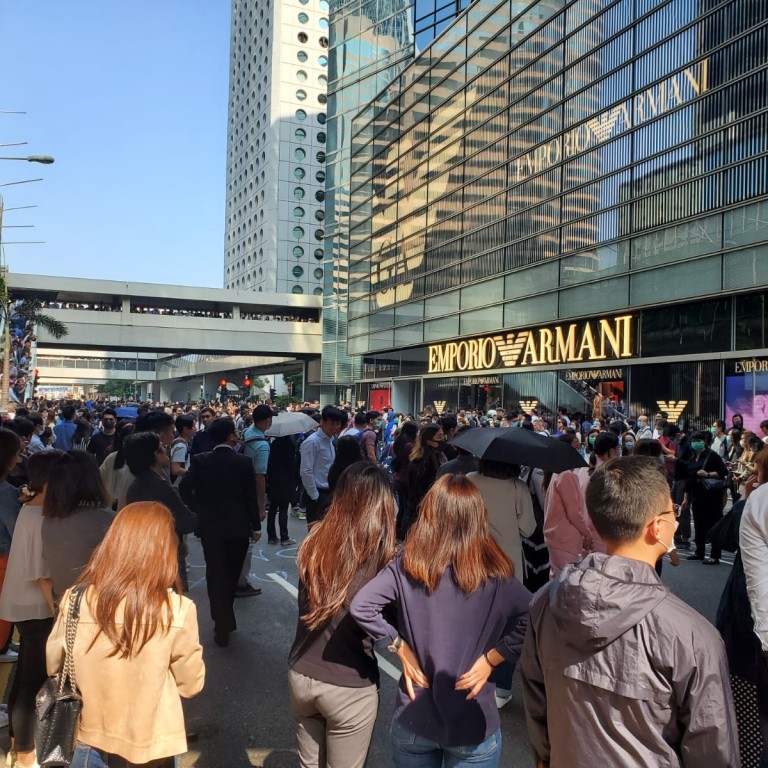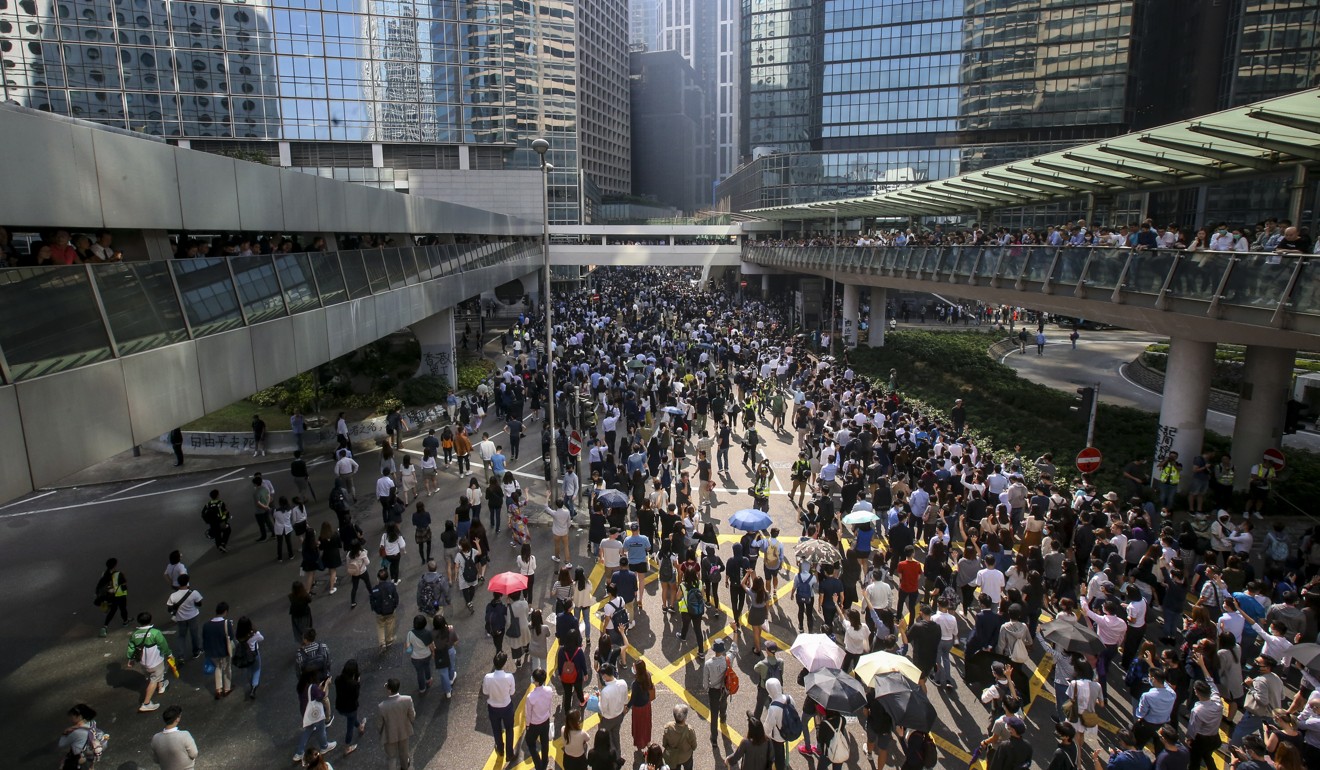
Hong Kong protests: lunchtime demonstrations extend across city with hundreds of people blocking roads
- Crowds out in Central, Tai Koo, Causeway Bay and Wong Chuk Hang
- In Central, there was a noticeably reduced presence of radical protesters, identified by their black clothing
Hong Kong’s lunchtime protests expanded on Friday from the Central and Tai Koo business districts to more locations such as Causeway Bay and Wong Chuk Hang, with hundreds of participants at each spot and major roads again blocked.
At 12.30pm, the crowd which converged in Central set foot on Pedder Street and blocked two lanes, leaving one for traffic. It was led by a few masked men in suits, followed by a few protesters dressed in black who blocked all three lanes as they chanted “Five demands, not one less”.
That chant was also in use in Tai Koo, where a small crowd gathered in the square outside the One Island East office building. They walked from Westlands Road and blocked King’s Road.
In Wong Chuk Hang, protesters built a roadblock using construction barriers from a nearby work site, as hundreds marched along Wong Chuk Hang Road.

Protesters in Wong Chuk Hang dug up pavement bricks and set up a roadblock in the now familiar pattern, with two upright bricks and another, horizontal, stacked on top.
Messages also circulated on LIHKG, the popular online platform, with activists calling for more protests in 11 places in Kowloon and the New Territories at 3.30pm. Those locations included Hung Hom, Kwun Tong, Fo Tan, Tai Po and Tuen Mun.
Wilson, a legal clerk who works in Central, said he had been attending the marches at lunchtime since Monday.
“The government likes to urge us to cut ties with those who resort to violence,” he said. “But we are here to show we are one united front.”
The 30-year-old said some protesters might be violent, but the root cause was that the government had tolerated police brutality.
“We are defending our last shred of freedom,” he said.
One woman tried to remove the bricks placed on the floor in Central, but was stopped by a group of protesters who asked to her to leave.
The woman, who asked the Post not to disclose her name for fear of being doxxed, said protesters should respect the rights of others.
“Why are they allowed to destroy the place we all live in?” said the woman, who was born and raised in Hong Kong.
She said in a democracy, if protesters had the right to place bricks on the floor, others should have the right to remove them.
“It has gone too far. What about the regular people?” she said.
Soon after the marches started in Central, Causeway Bay, Tai Koo and Wong Chuk Hang, another smaller march started in the business district of Kwun Tong. Protesters marched along one lane of Kwun Tong Road shouting “Hongkongers, take revenge”, but did not set up roadblocks. The march ended just before 2pm, with protesters going back into their office buildings as they clapped and shouted “add oil”.
Meanwhile, protesters on East Point Road in Causeway Bay spilled out onto Hennessy Road in front of the Sogo department store. Riot police arrived, but only to ask protesters to return to the pavements and to use the pedestrian crossing properly.
Police stayed on to ensure the road remained clear for vehicles as people alternated between shouting slogans and heckling the police.
Protest supporters question radical actions – but blame still pinned on government
In Wong Chuk Hang and Tai Koo, black-clad protesters began digging up bricks and setting up roadblocks. Six lanes on Wong Chuk Hang Road and lanes on Heung Yip Road were blocked, while in Tai Koo, the junction between King’s Road and Kornhill Road was covered with stacked bricks.
However, a rumour spread that police were arriving, causing masked protesters in both locations to disperse.
In Central, there was a noticeably reduced presence of radical protesters, identified by their black clothing. One protester thought it was because of a message circulated through their social media channels calling for Friday to be a “rest day”.
At Kowloon Masjid and Islamic Centre in Tsim Sha Tsui, the city’s biggest mosque, some 300 Muslims gave a special prayer for the city.
Chief Imam Muhammad Arshad began with a sermon at noon, and gave his congregation a message of peace. “Hong Kong has always been a very peaceful place, and we want that to continue,” he said.
“We as the Muslim community are not away from the current situation; we are part of the society. We are suffering from this, as other people are suffering. But we can play a role in reconciliation,” he said. The community was particularly involved in the chaos when a police water cannon fired blue dye at the mosque entrance during a dispersal operation last month. The force and city leader Carrie Lam Cheng Yuet-ngor subsequently apologised.
“Different religious communities have lived side by side. There is harmony and peace and it shall prevail,” Arshad added. He did not elaborate on how the government or protesters should restore peace in a week marred by escalated violence.



